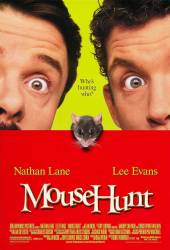Continuity mistake: When Ernie picks up the cereal pack and walks to the table, the mouse has chewed a hole in the pack, and cereals drops on the floor (the whole pack of cereals). And later in a shot from a different angle, the cereal is gone.
Continuity mistake: When the brothers go into the attic, there is a large portrait facing away from the walls that it is propped against. They open a box and moths are released. The fat one gets hit by a pole, and wanders across the room. He then appears with his head through the painting. His head would have gone through the painting the other way, as it was facing us, not the wall.
Continuity mistake: When Ernie is auctioning away the house, he has two papers on the table, but when he falls three papers fly in the air.
Continuity mistake: In the scene where the mouse is trapped behind the skirting board by the nails fired by the nail gun, we see at least 5 nails, yet on the exterior shot of the same skirting board, where Lee Evans is about to hammer in a protruding nail, we only see 2 nails in the board.






Answer: It survived because it's funny. Just like it survived everything else the brothers tried to do to it.
Grumpy Scot